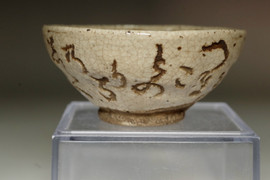Otagaki Rengetsu (1791-1875) Antique pottery cup #5139
- SKU:
- 5139
- Shipping:
- Free Shipping
Width: approx. 9cm (3 35⁄64in)
Height: approx. 4cm (1 37⁄64in)
Weight: 88g
poem: Sorry, we couldn't find it.
The charm of Otagaki Rengetsu’s works lies in their profound spirituality and simple beauty. Her poetry (waka) and calligraphy delicately express Buddhist enlightenment, impermanence, and the beauty of nature. Her brushstrokes are graceful yet restrained, and the fusion of poetry and calligraphy creates a unique aesthetic harmony. In her pottery, such as tea bowls, cups, and vases, the irregular shapes evoke the forms of nature, and their simplicity offers both practicality and a sense of peace.
Her works frequently reflect themes of nature, the changing seasons, and the Buddhist concept of impermanence, offering viewers moments of quiet reflection and insight. Motifs like the moon and flowers, which often appear in her works, symbolize both the transience and beauty of life. Additionally, Rengetsu’s warm personality and humanity shine through in her creations. Her pottery, marked by traces of her hands, and her heartfelt calligraphy convey deep spiritual satisfaction to those who use or view them.
Rengetsu’s works transcend mere technique, radiating a warmth that reflects her humanity. The graceful naturalness and spiritual richness that permeate her creations are key aspects of their lasting appeal.
Otagaki Rengetsu
Otagaki Rengetsu (1791-1875) was a Buddhist nun who is widely regarded as one of the greatest Japanese poets of the 19th century. She was adopted at a young age by the Otagaki family. It is said that she didn’t live a happy life because she lost her adoptive father and five brothers from illness. She married, but her husband died soon after. She remarried but lost this husband too from illness after only four years, as well as her young son and three young daughters. She joined the temple Chion-in and became a nun, taking Rengetsu ("Lotus Moon") as her Buddhist name. She made pottery inscribed with her poems with a spike in order to make a living. Fortunately her products became popular and she became very wealthy. However she continued to live a simple life. She donated a large amount of money during a famine in the 1850’s and devoted herself to saving the poor late in life.













